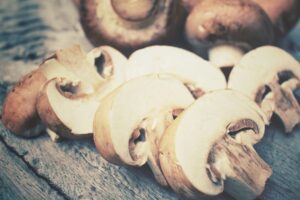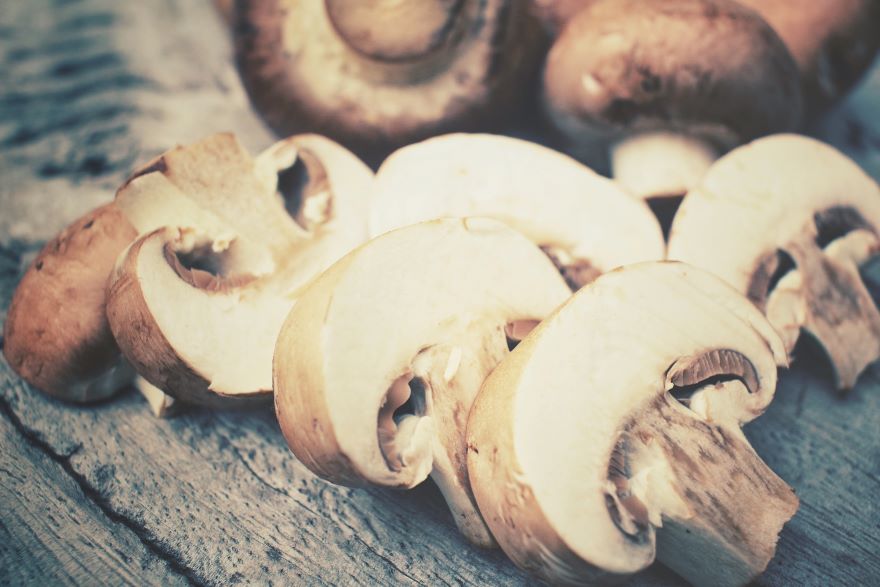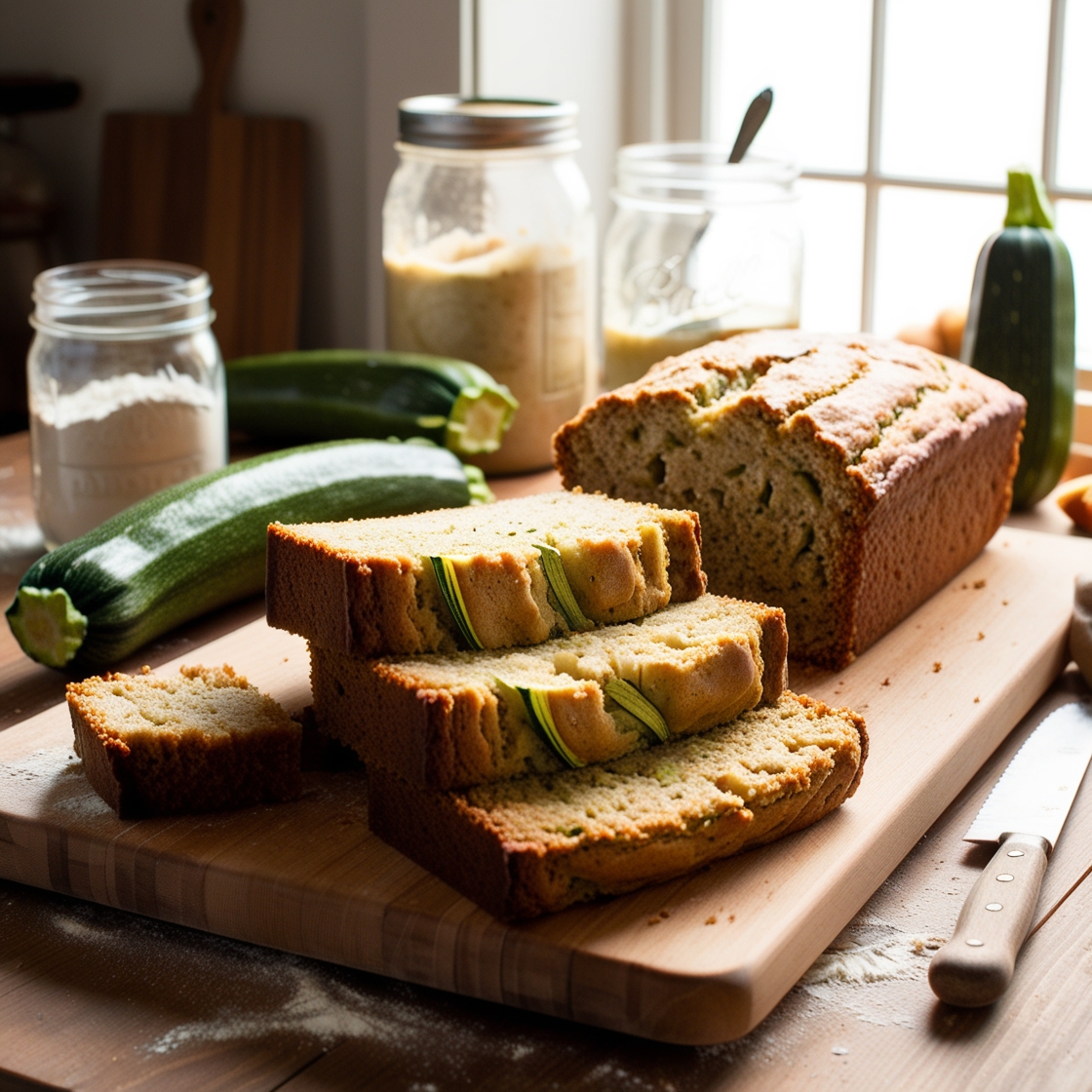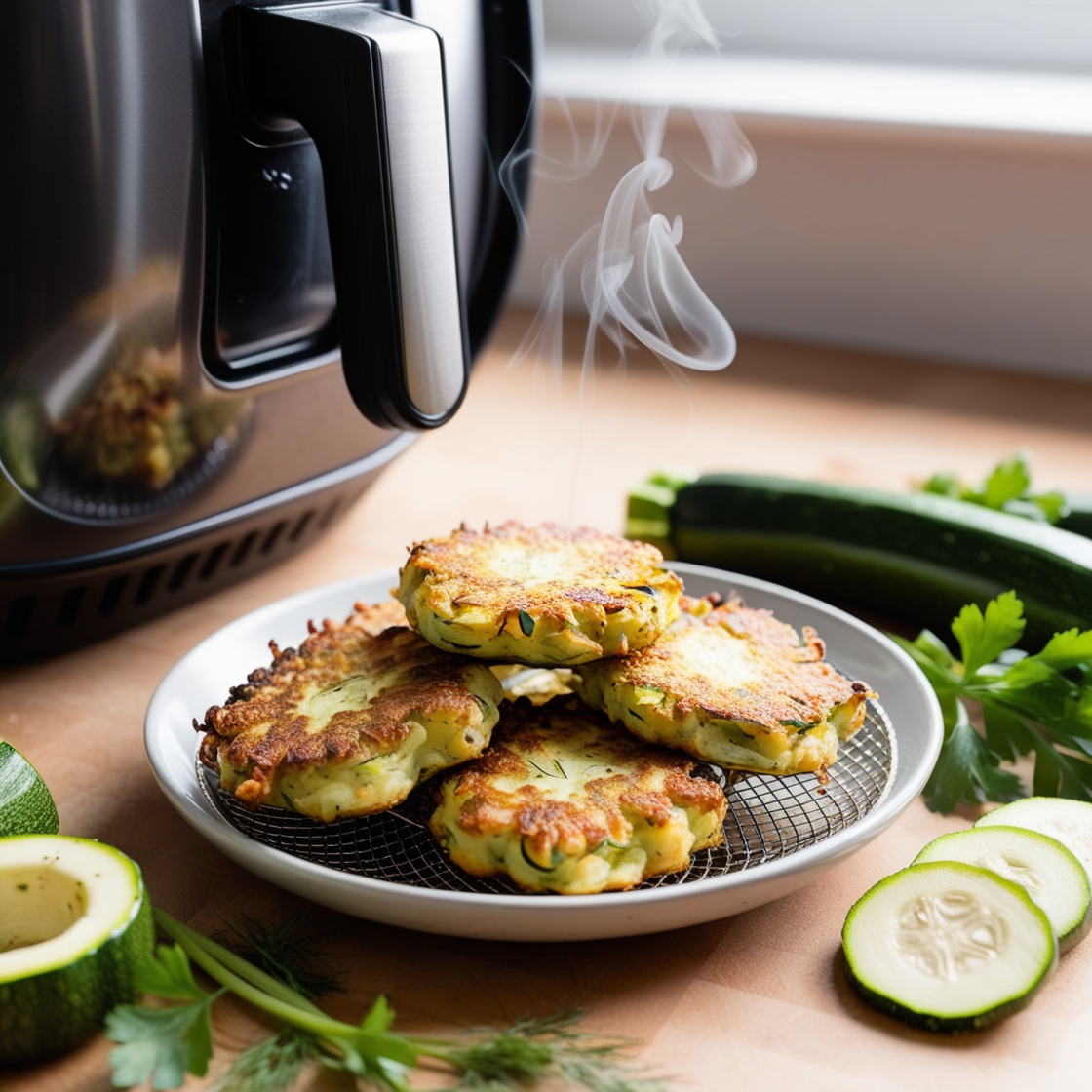Champignon mushrooms, also known as Agaricus bisporus, are an incredibly popular edible mushroom found in many culinary dishes around the world. These versatile fungi come in two color states while immature, white and brown, and are commonly referred to as button, table, or common mushrooms. In their mature state, they are well-known as portobello mushrooms.

In addition to their delicious taste, champignon mushrooms are highly regarded for their nutritional content and numerous health benefits. Rich in vitamins and minerals, these mushrooms can help boost your overall health and wellness. Their unique properties make them a favorite among both amateur and professional chefs for their ease of preparation, storage, and compatibility with a wide range of recipes.
Key Takeaways
- Champignon mushrooms are a popular and versatile edible mushroom used in many dishes worldwide.
- These mushrooms pack a punch with nutrients and offer numerous health benefits.
- Champignon mushrooms are easy to prepare, store, and use in various culinary creations.
Cultivation and Varieties
Cultivating Champignons
As a mushroom enthusiast, I’ve learned that cultivation of champignon mushrooms (scientifically known as Agaricus bisporus) starts with preparing nutrient-rich substrates, often composed of composted material like horse manure, straw, and gypsum. It’s essential to sterilize the substrate to ensure there are no competing organisms that can harm the mushrooms. If you’re interested in more insights into the cultivation process, you can take a look at this research paper.
Different Mushroom Varieties
In my experience, I’ve discovered that there are a variety of mushrooms falling under the Agaricus bisporus umbrella, some of which include:
- Button mushroom: These mushrooms are the most commonly cultivated and can be easily identified by their white, rounded cap and short stem. Harvesters usually pick them when they are young before the cap opens and turns into a mature mushroom.
- White mushrooms: Also popular, they’re very similar to button mushrooms but slightly larger with a more open cap. They’re perfect for salads, stir-fries, and sautéing.
- Portobello mushroom: A fully grown and mature white mushroom, with a large, open cap, and a robust, meaty texture. It’s fantastic when grilled or stuffed, and sometimes used as a meat alternative in vegetarian dishes.
- Chestnut mushroom: This variety has a light brown cap and is sometimes called cremini or brown mushrooms. They have a deeper and more earthy flavor, making them a great addition to sauces and risottos.
By understanding the cultivation process and various varieties of champignon mushrooms, we can appreciate this versatile fungus and the important role it plays in our culinary adventures. Personally, I find that experimenting with the different varieties adds depth and unique flavors to my dishes, while also benefiting from their nutritional properties.
Culinary Uses

Cooking with Champignons
Champignon mushrooms are a popular ingredient in many dishes due to their versatile nature and mild flavor. When I cook with fresh champignons, I often sauté them in butter or olive oil with a bit of salt, pepper, and garlic to enhance their taste. They have a tender texture that works well with a variety of culinary styles, making them a staple in my kitchen.
Sometimes, I like to incorporate champignons into French dishes or stews, where their subtle flavor complements the other ingredients without overpowering them. They also work well as a base for sauces, providing a smooth texture and delicate taste that pairs nicely with pasta or meat.
Recipes and Pairings
There are countless recipes that call for champignon mushrooms, but some of my favorites include:
- Mushroom Risotto: A creamy, flavorful dish made with Arborio rice, white wine, and Parmesan cheese. I love adding sautéed champignons to this classic Italian recipe for added depth and texture.
- Cream of Mushroom Soup: A rich and velvety soup that showcases the delicate flavor of champignons. I make mine with a blend of heavy cream, chicken broth, and a touch of sherry for an unbeatable flavor combination.
- Coq au Vin: A rustic French dish made with chicken, red wine, and a variety of vegetables. The addition of sautéed champignons brings an earthy element that takes this dish to the next level.
Champignons also pair well with various ingredients and cuisines. A few combinations that I have tried and enjoyed are:
- Pasta dishes, such as fettuccine Alfredo or spaghetti carbonara, where the champignons add a textural contrast and complementary flavor.
- Meat dishes, particularly those featuring beef or chicken, where the champignons can absorb the flavors of the dish and add a subtle earthiness.
- Vegetable stir-fries, as the mild taste of champignons allows the other ingredients to shine while still contributing to the overall flavor profile.
Overall, champignon mushrooms are a versatile and delicious addition to many dishes, and I encourage you to explore their varied culinary uses.
Nutritional Benefits

Health Advantages
In my experience, mushrooms, particularly Champignon mushrooms, are not only delicious but also full of health benefits. As a person who loves mushrooms, I found out that these fungi are low in calories and packed with valuable nutrients. They offer a good amount of protein, carbohydrates, and contain essential minerals and B-vitamins that contribute to the proper functioning of our body. I’ve noticed that consuming mushrooms can even help boost the immune system due to their antioxidant properties.
It’s interesting to learn that mushrooms, especially white and Portobello varieties, are a rich source of selenium – an important nutrient that works as an antioxidant in the body to protect cells from damage. They also contain an adequate amount of phosphorus which helps with the maintenance of strong bones and teeth. I appreciate that mushrooms also bring in vitamins and minerals like vitamin C, potassium, and other B-vitamins to my diet.
Nutritional Components
I’ve come to realize that not all mushrooms are created equal when it comes to nutritional value. For instance, the nutritional profile of dried mushrooms may slightly differ from those of fresh mushrooms. However, talking about Champignon mushrooms, the nutritional components are usually consistent. As an avid mushroom consumer, I often find solace knowing that they are a good source of nutrients regardless of whether they are fresh or dried.
Curiosity led me to discover that the vitamin D content in mushrooms mostly depends on how growers cultivate and process them. Generally, mushrooms grown in controlled environments indoors might contain little to no vitamin D. However, exposing them to ultraviolet light, either through sunlight or UV lamp, can increase their vitamin D content (Harvard T.H. Chan School of Public Health).
In my quest to explore the world of mushrooms, I stumbled upon a unique aspect where traditional knowledge and use of wild mushrooms play a significant role in preserving biodiversity in some cultures, such as the Mixtecs or Ñuu Savi in Mexico (NCBI). I find it fascinating that these communities deeply root their understanding of mushrooms’ nutritional components and their potential health benefits in wisdom.
I hope that by continuing to incorporate mushrooms into my diet, I can embrace their nutritional benefits and keep supporting sustainable food sources.
Health and Wellness
Mushroom Health Research
I’ve discovered that champignon mushrooms, also known as white or Agaricus bisporus mushrooms, are not only delicious but they also possess numerous health benefits. These mushrooms have a reputation for being rich in antioxidants that help protect our cells from damage caused by free radicals. This makes them a great addition to a healthy diet focused on fighting inflammation and improving heart health.
Further research has shown that polysaccharides found in mushrooms may contribute to strengthening our immune system. Some studies, such as one on breast cancer treatment, suggest that dietary supplementation with certain medicinal fungi may have potential benefits for people with specific health conditions.
Incorporating Mushrooms into a Healthy Diet
When it comes to including champignon mushrooms in my diet, I’ve learned that their versatility and nutrient profile make them an excellent choice. Since these mushrooms are an amazing source of copper, incorporating them into meals can help ensure I meet my daily copper needs, which is essential for maintaining good health. Additionally, they are low in calories and high in fiber, making them an ideal choice for those looking to manage their weight.
I have also discovered that these mushrooms can help maintain healthy cholesterol levels. Due to their unique nutrient composition, champignon mushrooms may contribute to proper cholesterol regulation and overall heart health.
To get the most benefits from champignon mushrooms, I recommend including them in various dishes. They can be sautéed, grilled, or even enjoyed raw in salads. Their earthy and mild flavor make them suitable for any meal, and their health benefits only add to their allure. So next time you plan a meal, consider giving champignon mushrooms a role in your recipes and see how they can elevate your health and wellness.
Preparation and Storage
Proper Mushroom Handling
When it comes to handling fresh champignon mushrooms, I always make sure to examine their appearance first. A good indicator of quality is a firm texture, and a clean, unblemished cap and stem. The tightly closed gills under the cap indicate freshness.
Now, I know that it can be tempting to wash mushrooms right after bringing them home. However, I’ve learned that it’s best to avoid rinsing them until they’re ready for use. This is because mushrooms, especially the cultivated variety, can absorb water like a sponge, and too much moisture might affect their texture negatively. Instead, I prefer gently wiping away any dirt or debris with a damp paper towel or a soft mushroom brush.
If I happen to have any dried champignon mushrooms, I like to reconstitute them before using them in a dish. To do this, I simply soak them in warm water for approximately 20-30 minutes, then drain and pat them dry.
Storage Tips
Proper storage is essential for preserving the quality and flavor of champignon mushrooms. I’ve found that these mushrooms stay fresh for up to a week when stored correctly.
For fresh mushrooms, it’s best to avoid plastic bags or containers, as they can trap moisture and cause the mushrooms to become slimy. Instead, I place the whole, unwashed mushrooms in a brown paper bag and fold the top of the bag over. I then store the bag in the main compartment of my refrigerator, where the paper bag helps absorb any excess moisture.
If I’m working with dried mushrooms, I store them in an airtight container in a cool, dark place. This helps maintain their shelf life, which can be up to a year or even longer.
Remember, by following these preparation and storage tips, I ensure the best possible taste and texture for my champignon mushrooms, whether I use them in a simple appetizer or as a delicious addition to a hearty meal.
Frequently Asked Questions
What are the culinary uses of Champignon mushrooms?
I’ve found that there are many ways to incorporate Champignon mushrooms in everyday meals. Chefs often use them in a variety of dishes such as stir-fries, soups, pasta, and even as stuffed appetizers due to their versatility. You can also sauté, roast, or grill them as a flavorful side dish.
What distinguishes Champignon mushrooms from other mushroom varieties?
As I discovered, many consider Champignons to have a more flavorful, denser texture compared to other Agaricus bisporus varieties like button mushrooms. They have a mild, earthy taste that can enhance the flavors of various dishes. Their color can vary from white to light brown, which differentiates them on a visual level as well.
What is the nutritional value of Champignon mushrooms?
Champignon mushrooms are not only delicious but also offer a variety of health benefits. They are low in calories and fat, making them a great addition to a healthy diet. Moreover, they’re a good source of vitamins, minerals, and fiber, as well as being high in antioxidants that can support overall health and vitality.
How does the price of Champignon mushrooms compare to other varieties?
In my experience, the price of Champignon mushrooms is generally similar to other common varieties, such as button or cremini mushrooms. However, their price can vary depending on factors such as the season, availability, and region where they are grown or sold.
Can Champignon mushrooms be found in the wild, and if so, where?
Although Champignon mushrooms are primarily grown commercially for consumption, it is possible to find them growing naturally in the wild. They are often found in grassy areas, including gardens, meadows, and pastures. When foraging for wild mushrooms, you should always exercise caution and ensure that you correctly identify the fungus before consuming it.
How should Champignon mushrooms be cleaned and prepared for cooking?
To properly clean and prepare Champignon mushrooms for cooking, I like to gently brush off any dirt or debris with a cloth or soft brush. Avoid washing them with water as it can cause them to become soggy. Once they’re clean, you can simply trim the stem ends and slice or chop them as needed for your dish. It’s important to remember that adding salt during cooking should be done towards the end to preserve the mushrooms’ moisture content.

*We may earn a commission for purchases made using our links. Please see our disclosure to learn more.



